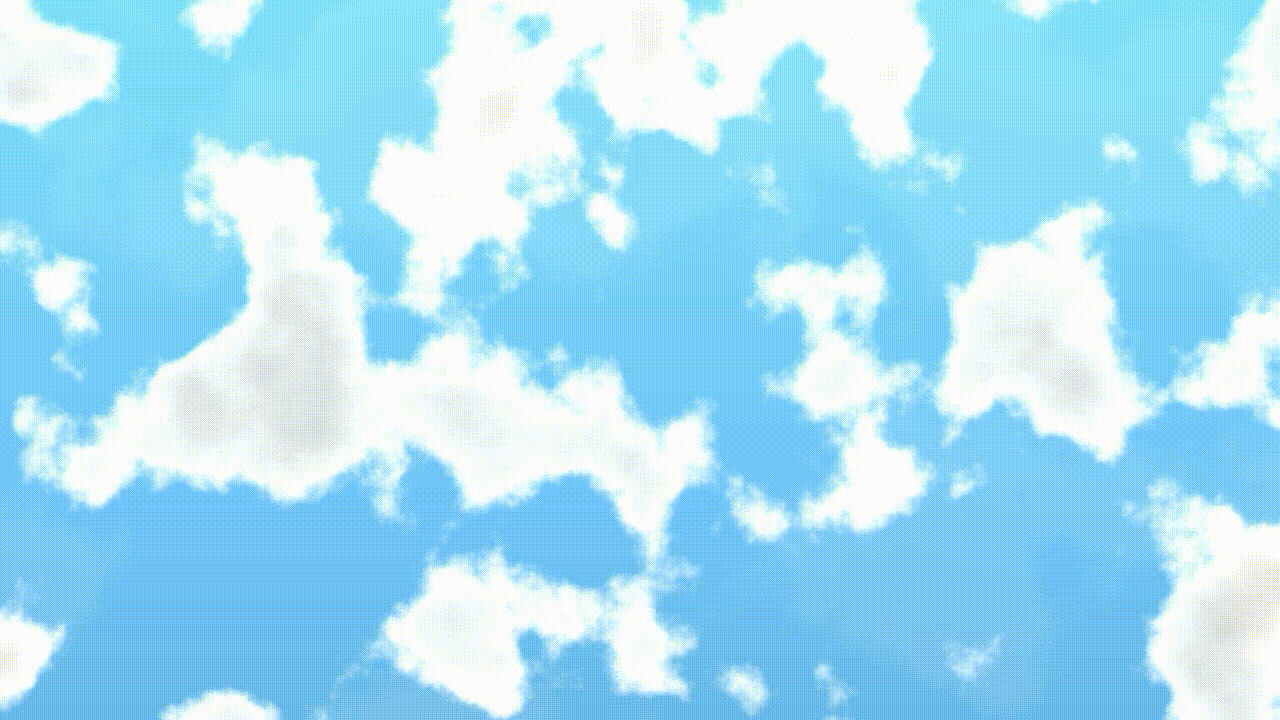
Introduction
This shader creates a dynamic sky with drifting clouds using Perlin noise and layered blending techniques. Instead of relying on bitmap textures, it generates everything procedurally, making it scalable and resolution-independent.
How It Works
1. Base Colors
- Sky: a soft blue gradient (
vec3(0.4, 0.70, 0.9)). - Clouds: pure white (
vec3(1.0)).
2. Noise Functions
hash(vec2 p)generates pseudo-random gradients.perlin(vec2 p)implements smooth Perlin noise interpolation.- These form the foundation of the cloud shapes.
3. Layered Perlin Noise
stackedWavedPerlin stacks 8 octaves of Perlin noise:
- Each octave doubles frequency and halves amplitude (fBm).
- Offset samples (
+0.1,-0.1) create a wave-like drift. - Animation is driven by
iTime, simulating cloud movement.
4. Sky Gradient and Blending
The shader mixes noise with a vertical blue gradient:
smoothsteplayers soften cloud edges.- Multiple blends simulate light scattering inside clouds.
- Results in natural-looking, soft formations.
5. Final Composition
The sky texture is sampled at different scales (uv * 4.0, uv * 2.0), then combined to add extra detail.
Conclusion
- Procedural: No image textures needed.
- Dynamic: Clouds move and evolve over time.
- Stylized Realism: Smooth, layered blending mimics atmospheric scattering.
This approach is widely used in games, simulations, and generative art to produce skies that feel alive without heavy assets.
vec3 SKY_COLOR = vec3(0.4, 0.70, 0.9);
vec3 CLOUDS_COLOR = vec3(1.0);
vec2 hash(vec2 p) {
p = vec2(dot(p, vec2(127.1, 311.7)), dot(p, vec2(269.5, 183.3)));
return -1.0 + 2.0 * fract(sin(p) * 43758.5453123);
}
float perlin(vec2 p) {
vec2 i = floor(p);
vec2 f = fract(p);
vec2 u = f * f * (3.0 - 2.0 * f);
return mix(mix(dot(hash(i + vec2(0.0, 0.0)), f - vec2(0.0, 0.0)),
dot(hash(i + vec2(1.0, 0.0)), f - vec2(1.0, 0.0)), u.x),
mix(dot(hash(i + vec2(0.0, 1.0)), f - vec2(0.0, 1.0)),
dot(hash(i + vec2(1.0, 1.0)), f - vec2(1.0, 1.0)), u.x), u.y);
}
float stackedWavedPerlin(vec2 uv) {
float n = 0.0;
float amp = 1.0;
float freq = 1.0;
for (int i = 0; i < 8; i++) {
n += perlin(uv * freq + iTime * freq * 0.1) * amp;
n += perlin(uv + 0.1 * freq + iTime * freq * 0.1) * amp * 0.25;
n += perlin(uv - 0.1 * freq + iTime * freq * 0.1) * amp * 0.25;
freq *= 2.0;
amp *= 0.5;
}
return n;
}
// Please let me know how I can improve the `skyTexture`
vec3 skyTexture(vec2 uv) {
float m = stackedWavedPerlin(uv);
vec3 gradientSky = mix(SKY_COLOR * 0.95, SKY_COLOR, uv.y);
vec3 c1 = mix(gradientSky, CLOUDS_COLOR, smoothstep(0.0, 0.5, m * 2.5));
vec3 c2 = mix(c1, CLOUDS_COLOR / 1.05, smoothstep(0.0, 1.25, m * 2.));
vec3 c3 = mix(c2, CLOUDS_COLOR / 1.2, smoothstep(0.0, 1.5, m * 1.5));
vec3 c4 = mix(c3, CLOUDS_COLOR / 1.75, smoothstep(0.0, 2.5, m));
return c4;
}
void mainImage(out vec4 fragColor, in vec2 fragCoord) {
vec2 uv = fragCoord / iResolution.y;
vec3 t = skyTexture(uv * 4.);
t += skyTexture(uv * 2.) * 0.1;
fragColor = vec4(t, 1.);
}